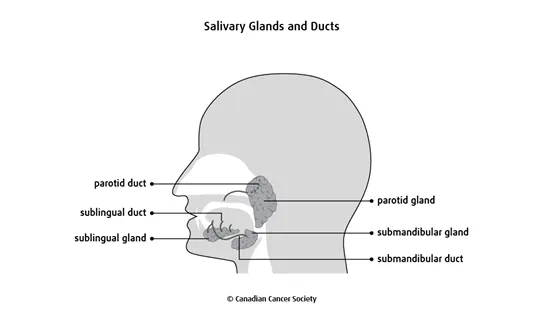The salivary glands
The salivary glands are divided into major salivary glands and minor salivary glands.

Major salivary glands
The major salivary glands are the larger salivary glands that produce most of the saliva. There are 3 types of major salivary glands.
The parotid glands are the largest salivary glands. There are 2 parotid glands, one in front of each ear on either side of the face. The parotid gland is divided into 2 lobes, one on each side of the facial nerve. The superficial lobe is closest to the front of the neck. The deep lobe is deeper in the neck tissues.
The submandibular glands are smaller than the parotid glands. There are 2 submandibular glands. Each gland is behind the lower jaw, just under the chin and tongue, on either side of the face.
The sublingual glands are the smallest of the major salivary glands. There are 2 sublingual glands. Each gland is deep in the floor of the mouth, on either side of the tongue. Saliva from the sublingual glands enters the mouth through many tiny sublingual ducts.
Minor salivary glands
There are 750 to 1000 minor salivary glands. They are very small. Most of them are too small to be seen with the naked eye.
About half of all minor salivary glands are on the hard palate in the roof of
the mouth. Minor salivary glands are also found in the lips, cheeks, nose,
sinuses around the nose (called paranasal sinuses),
Function
Salivary glands play an important role in digestion because they make saliva. Saliva helps moisten food so we can swallow it more easily. It also has an enzyme called amylase that makes it easier for the stomach to break down starches in food.
Saliva also has an important role in our oral health. It prevents infections in the mouth and throat. It also helps to maintain healthy teeth and prevent bad breath. Saliva also moistens the oral cavity, which helps with swallowing and speaking.
Your trusted source for accurate cancer information
With support from readers like you, we can continue to provide the highest quality cancer information for over 100 types of cancer.
We’re here to ensure easy access to accurate cancer information for you and the millions of people who visit this website every year. But we can’t do it alone.
Every donation helps fund reliable cancer information, compassionate support services and the most promising research. Please give today because every contribution counts. Thank you.
